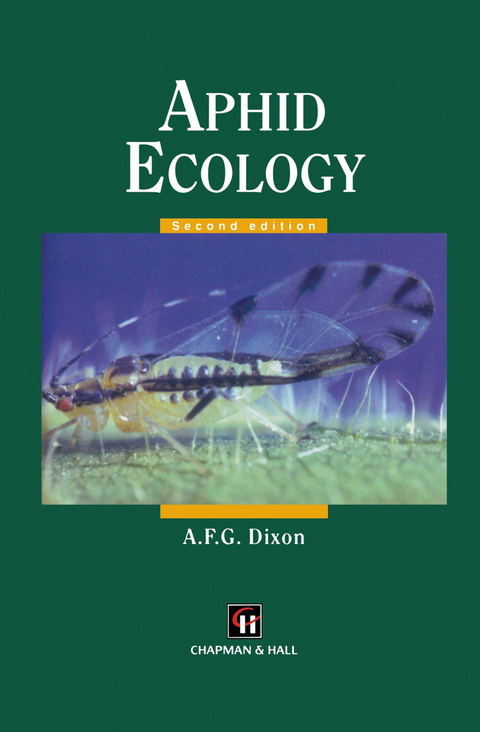
Aphid Ecology An optimization approach
Springer (Verlag)
978-94-010-6480-4 (ISBN)
Aphids are the most important of the sap sucking insects, they are also major pests of agriculture, horticulture and forestry. This book covers the evolution of aphids and their development in relation to specific plants. Optimization is used to explain how modes of feeding and reproduction have affected their size and population structure and led to a very close and specific association with their host plants.
Increasing knowledge of aphids has revealed that they are ideal organisms to use when studying many topical ecological issues. They are particularly important for testing predictions of life history theory, as their clonal structure makes it possible to test the response of a genotype to a wide range of conditions.
Aphid Ecology has been thoroughly revised and expanded since the first highly successful edition was published in 1985. This book is aimed at specialists, post graduates and advanced undergraduates working in the fields of ecology and entomology.
1 Introduction.- 1.1 Distinguishing features of aphids.- 1.2 Origin of aphids.- 1.3 Host plant associations.- 1.4 Classification.- 1.5 Distribution.- 2 Feeding behaviour and food quality.- 2.1 Feeding behaviour.- 2.2 Food quality.- 2.3 Nitrogen metabolism.- 2.4 Symbionts.- 3 Host specificity and speciation.- 3.1 Proximate factors in host selection.- 3.2 Food quality.- 3.3 Evolution of host specificity.- 3.4 Speciation.- 4 Size.- 4.1 Size within a species.- 4.2 Optimum body size.- 4.3 Species size diversity.- 4.4 Geometrical similarity.- 4.5 Size of migrants.- 4.6 Reproduction.- 5 Resource tracking: mechanism — cyclical parthenogenesis.- 5.1 Telescoping of generations.- 5.2 Intra-clonal variation.- 5.3 Adaptability of aphid clones.- 5.4 Genetic structure.- 5.5 Sex.- 5.6 Why reproduce sexually?.- 5.7 Timing of sex.- 5.8 Sex ratios.- 5.9 Mate guarding.- 5.10 Why lay eggs?.- 6 Resource tracking: mechanism — polyphenism.- 6.1 Defence.- 6.2 Dispersal.- 6.3 Reproduction.- 6.4 Parthenogenetic reproduction.- 6.5 Sexual reproduction.- 6.6 Aestivation and hibernation.- 6.7 Ecological patterns.- 7 Resource tracking in time.- 7.1 Host alternation.- 7.2 The historical debate.- 7.3 Experimental evidence.- 7.4 Autoecious way of life.- 7.5 Generation-specific strategies.- 7.6 Habitat predictability and tactical diversity.- 7.7 Response to habitat quality.- 8 Resource tracking in space.- 8.1 Mechanisms.- 8.2 Timing.- 8.3 Distance travelled.- 8.4 Adaptive significance.- 9 Population dynamics.- 9.1 Dynamics of aerial populations.- 9.2 Intensive studies.- 9.3 Patterns.- 9.4 Processes.- 9.5 Natural enemies.- 9.6 Intraspecific differences in abundance.- 9.7 Interspecific differences in abundance.- 9.8 Abundance and global warming.- 9.9 Forecasting of pest aphid outbreaks.- 9.10 Spatialdynamics.- 10 Community structure and species diversity.- 10.1 Mutualism between plants and aphids.- 10.2 Aphids and plant growth.- 10.3 Aphids and the seeding of plants.- 10.4 Ants and plant fitness.- 10.5 Mutualism between aphids and ants.- 10.6 Endophyte-enhanced plant resistance to aphids.- 10.7 Energy and nutrient flow.- 10.8 Competition.- 10.9 Species diversity and plant architectural complexity.- 10.10 Size diversity.- 10.11 Distribution, abundance and variability.- 10.12 Rarity.- 10.13 Why are there so few species of aphids, especially in the tropics?.- 11 Epilogue.- References.
| Zusatzinfo | IX, 300 p. |
|---|---|
| Verlagsort | Dordrecht |
| Sprache | englisch |
| Maße | 155 x 235 mm |
| Themenwelt | Naturwissenschaften ► Biologie ► Botanik |
| Naturwissenschaften ► Biologie ► Evolution | |
| Naturwissenschaften ► Biologie ► Ökologie / Naturschutz | |
| Naturwissenschaften ► Biologie ► Zoologie | |
| ISBN-10 | 94-010-6480-6 / 9401064806 |
| ISBN-13 | 978-94-010-6480-4 / 9789401064804 |
| Zustand | Neuware |
| Haben Sie eine Frage zum Produkt? |
aus dem Bereich


